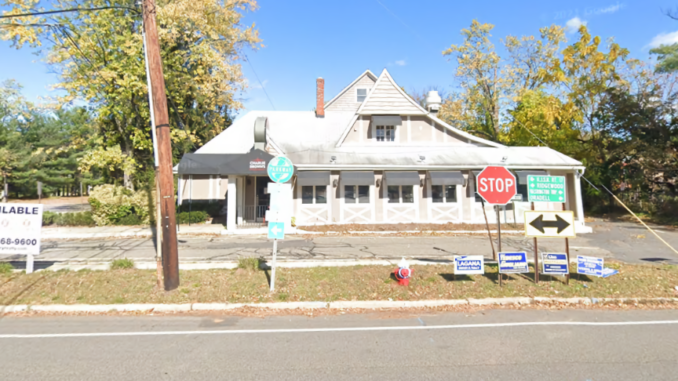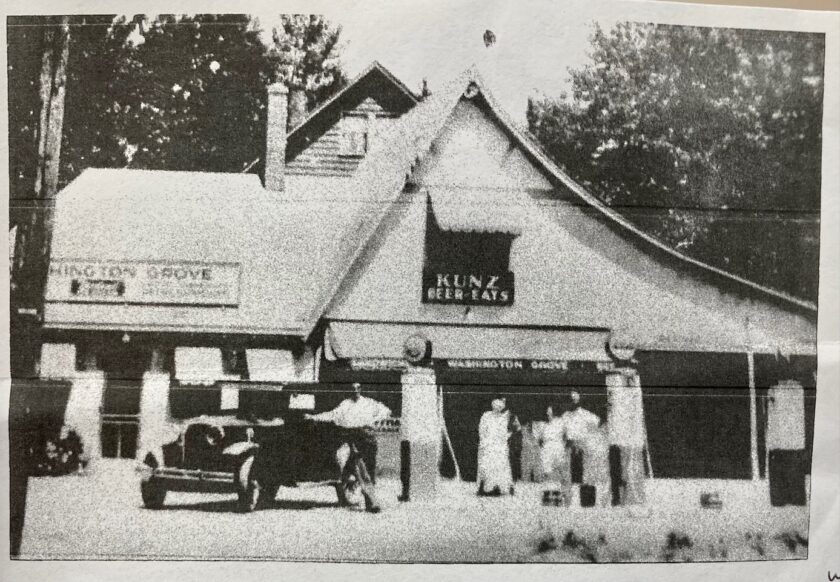
TOWNSHIP OF WASHINGTON—An environmental consultant investigating older uses of the 95 Linwood Ave. site for gas station operations has found indications of a possible underground storage tank and piping and recommends $12,000 to $17,000 more to further investigate the extent of possible on-site contamination, according to its June 13 report.
The previous Phase II environmental study used ground penetrating radar to determine if any underground signs of prior historical fuel storage were present near the middle of the site behind the former Charlie Brown’s restaurant and found none.
However, a resident questioned those findings and wondered why officials or Lisko Environmental, the township’s consultant, did not check the front of the property where an archival photo shown at a previous public meeting showed at least three gas pumps on the site.
Given the new revelations, it was unclear what the mayor and council may decide to do. Whether the council wishes to authorize more spending to investigate further will likely be a topic at the council next meeting, June 20.
At the June 8 meeting, council members voted for a third environmental study costing $16,961 to find out whether any underground signs of the former gas pumps, such as underground storage tanks (USTs) and piping, were present. Initially, council rejected the third study, 3–2, but councilman Tom Sears changed his vote after coming out of closed session at nearly 1 a.m. on June 9.

“Based on the results of GPR (ground penetrating radar) scan, it’s reasonable to conclude the piping identified in the GPR scan was a portion of the historic UST system operated at the subject property,” noted the consultant’s executive summary provided on June 13.
The ground penetrating radar scans and soil test borings were completed June 9 to determine whether there was any indication of the prior gas pump usage and contaminants, said Lisko.
Originally, the township was under a June 14 deadline to conclude its due diligence on the property and decide whether to move ahead with its purchase. However, the township attorney said June 8 that the due diligence period was extended until July 18 by the owner.
Pascack Press received the third study via a public records request June 13.
“Given the subsurface anomalies consistent with a potential UST field and/or excavation proximal to the southwest corner of the existing building on the subject property, and the potential likelihood that this area may have been associated with USTs, LISKO recommends exploratory test pits be installed to verify the presence or absence of UST system components in this area,” notes the environmental report, prepared on an expedited schedule for township officials.
Eight soil borings were done on site, and three of the eight boring pits were converted into temporary groundwater sampling stations, said Lisko. None of the soil samples nor groundwater samples showed signs of contaminants above environmental standards, the report notes.
While no contamination was found, the consultant recommended removing any piping or USTs present, and the exploratory test pits to find out if more buried piping or tanks exist.
“Accordingly, LISKO recommends the UST system piping be closed in accordance with the Underground Storage Tank Rules at New Jersey Administrative Code (NJAC) 7:14B, including the removal and completion of the required notifications, sampling and reporting to the NJDEP,” the report states.
“For budgetary and conceptual planning purposes, it’s reasonable to anticipate costs ranging from $12,000 – $17,000 for exploratory borings and to close the existing UST system piping in accordance with applicable regulations. In the event that additional UST system components (i.e., underground storage tanks, additional piping, etc.) or contamination is identified, costs will be increased,” the report’s executive summary concludes.
At the June 8 meeting, both council president Desserie Morgan and councilman Steven Cascio voted against doing the third environmental study. Both said they were against purchasing the site for specific reasons. (See “Council wavers on deeper enviro look at 95 Linwood; DPW option lives on,” Pascack Press, June 13, 2022.)
However, the study was approved when Sears changed his vote and joined council vice president Stacey Feeney and councilwoman Daisy Velez to support the third study.
Before initially nixing the study in a first vote that failed 3-2, Sears said he was against the purchase because it was no longer for the DPW and he did not support moving the police department there, which now is Mayor Peter Calamari’s preferred use for the site. Sears said he would prefer the property back on the market and help the town meet its future affordable housing goals.
We are reaching out to council members for their reaction to the third environmental study. Feeney told Pascack Press on June 14 that she was still making her way through it, and was taking care with its technical aspects.
Morgan offered her assessment, telling Pascack Press, “I have even more reservations about moving forward with the property after reviewing the report. I don’t want to continue to spend money exploring whether or not there are additional environmental issues.”
“Being that we have no clear plan for the site my vote remains the same. I will not be voting to purchase the property,” she said.
After seeing the new consultant’s report, Hemlock Drive resident Rose Candeletti said, “I hope the town has found enough reason and doubt as well as spent enough money now to back out of the purchase of this property.” She said some council members and many residents “agree that the DPW should be rebuilt at town hall and that no immediate need exists to upgrade the police station.”
“They can give the residents a break on spending an extra $1.35 million for this property and they should go back to their four-year plan for a new police station,” she said.
Added Candeletti, “I hope they decide they spent enough money this time.”
